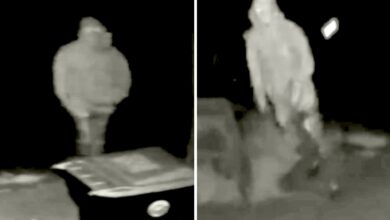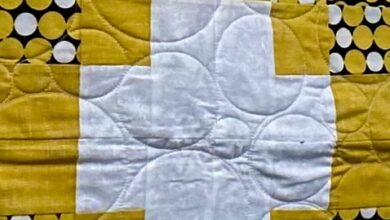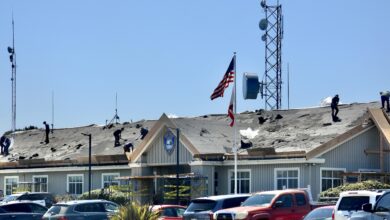SRA finds new causes, hopes salmon hatchery can play role
As always, funds raised in 2008 by the World”s Largest Salmon Barbecue go to salmon restoration causes.
New this year is that the non-profit Salmon Restoration Association is devoting its efforts to a single river, the Noyo, and seeking more causes for the future, while also hoping the hatchery that was its centerpiece for three decades can be put to some use.
Funds from the barbecue, which primarily went to hatchery operations in the past, are now being aimed at rivers closer to home, such as the Ten Mile, Albion and Noyo.
This year”s proceeds, above the direct costs of salmon and other materials, will be donated to the Noyo Watershed Alliance.
The Noyo Watershed Alliance draws on a consortium of agencies including both the Campbell Timber Company and Mendocino Redwood Company, the city of Fort Bragg, the Salmon Restoration Association, the Fort Bragg Lions Club and Jackson Demonstration State Forest.
Projects include fixing Sherwood Road to help slow erosion. The road, which turns to gravel between Fort Bragg and Willits, is a favorite spot for offroad activities, which cause serious erosion injuries.
Another activity is reconstruction of a bridge in a way that will improve salmon habitat.
Thanks to the generosity of property owner Christine Veith, the Salmon Restoration Association has a working salmon hatchery available for use on Hollow Tree Creek.
Only this year, the facility, located halfway between Westport and Leggett on Highway 1, isn”t working.
Veith and the SRA are hoping that the hatchery can be used again in the future as a scientific study station at some point by a university, environmental group or other large-scale effort.
The organization has been told by the federal National Oceanic and Atmospheric Administration that the hatchery would be required to conduct extensive monitoring. The previous hatchery manager estimated the cost of this monitoring to be more than $100,000 per year, which would quickly wipe out the SRA financially, so the facility was closed this year, meaning no salmon were reared.
The hatchery has been closed often over the years due to low water levels, but the SRA thinks it could still be a valuable piece in the huge, intricate puzzle of bringing back salmon populations.
“We are hoping people who come to the barbecue will help us find someone willing to help us and Christine find a use for this facility that is true to her family”s wishes,” said SRA President Joe Janisch.
“Christine has been very generous in being patient and willing to help us find a solution. It would be a shame to let that kind of generosity not be used,” Janisch said.
The SRA needs help for this to happen, as extensive paperwork and monitoring would be needed. Once salmon are hatched at the remote Hales Grove location, someone needs to be on site all the time from November through April. In the past, rugged individuals have been willing to sacrifice and put in long hours. With the SRA wishing to stick more to modern employment practices, the feasibility of such a small, non-profit organization performing a scientific, controversial task has become too much.
“The SRA is willing to be involved, but not run the hatchery by itself,” Janisch said.
A bigger issue may be the mixed reports that show hatcheries aren”t the best way to restore salmon populations.
After 30 years of effort on Hollow Tree Creek, the Eel River, California”s third longest, hasn”t bounced back, despite dollars and fish raised in the millions.
A river that once carried millions of fish now carries thousands of king salmon.
Historic, or “legacy” logging practices are mostly to blame. Modern logging companies spend as much time fixing the collapsing roads and damage of the past as they do logging.
A common practice of the past was simply to set out with a bulldozer, scraping off hillsides. Streambeds were used as pathways for heavy equipment to push logs, Janisch said. The long term results of this kind of “damn the future” practices were predictably bad.
The problem all over the Pacific Northwest, scientists say, is that the habitat problems that created the need for hatcheries haven”t been fixed and have gotten worse in many places. In some areas larger hatcheries have been identified as damaging biological diversity and have been closed or curtailed.
The federal agency NOAA is engaged in a “hatchery reform project.” Some critics see the result as closing down hatcheries, rather than reforming them.
2008 is the worst year on record for California salmon, with the state”s most important river, the Sacramento, suffering a catastrophic collapse in returning salmon numbers.
NOAA maintains a hatchery reform project Webpage which details the risks and benefits of hatcheries.
“Over the past several decades, wild salmon populations have declined dramatically, despite, and perhaps sometimes because of, the contribution of hatcheries … With this decline has come an increased focus on the preservation of indigenous wild salmon stocks,” the NOAA Webpage states.
“Hatcheries have the potential to assist in the conservation of wild stocks, but they also pose some risks. At this time, scientists still have many questions about the extent to which hatchery programs enhance or threaten the survival of wild populations. Additional research and investigation is needed,” the Webpage claims.
Commercial fishermen, such as the Salmon Trollers Association of Fort Bragg, say NOAA has some great scientists and good ideas but lacks cohesive direction.
The State of California seems headed in an opposite direction, reviving hatchery programs in response to the worst salmon return on record in the Sacramento River.
In response to the collapse of the fall run of chinook salmon in the Central Valley that resulted in the closure of all commercial and recreational salmon fishing, the state Department of Fish and Game has released a record-breaking 20.2 million young salmon in San Pablo Bay. The fish are expected to return to the Sacramento River System in two to four years
The outlook for 2009 is generally bad. Fishers are hoping for a much better season in 2010, with the hope that work on rivers, the ocean and hatchery science will allow the return of healthy fish populations and a healthy, more sustainable salmon fishing and processing industry.




